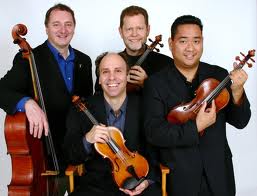|
Symphony
FROM THE NEW WORLD TO THE OLD WORLD
by Peter Lert
Saturday, June 14, 2025
Chamber
MC2 DUO RECITAL CLOSES 222'S SEASON
by Terry McNeill
Saturday, June 14, 2025
Choral and Vocal
CANTIAMO SONOMA'S LUSCIOUS A CAPELLA SINGING IN SEASON ENDING CONCERT
by Pamela Hicks Gailey
Sunday, June 8, 2025
Symphony
SRS SEASON ENDS WITH RESOUNDING TA-TA-TA-BANG
by Terry McNeill
Sunday, June 1, 2025
Symphony
YOUTHFUL VIRTUOSITY ON DISPLAY AT USO'S MAY CONCERTS
by Peter Lert
Saturday, May 17, 2025
Symphony
MYSTICAL PLANETS AND LIVELY GERSHWIN ORTIZ AT FINAL SRS CONCERT
by Peter Lert
Sunday, May 4, 2025
Symphony
VSO'S CONCERT MUSIC OF TIME, MUSIC OF PLACE
by Peter Lert
Sunday, April 27, 2025
VOCAL ELEGANCE AND FIRE AT THE 222'S RECITAL APRIL 26
by Pamela Hicks Gailey
Saturday, April 26, 2025
CANTIAMO SONOMA SINGS AN INSPIRED GOOD FRIDAY MOZART REQUIEM CONCERT
by Pamela Hicks Gailey
Friday, April 18, 2025
DRAMATIC SHOSTAKOVICH SYMPHONY CLOSES PHILHARMONIC'S 25TH SEASON
by Terry McNeill
Sunday, April 13, 2025
|
 |
 Alexander String Quartet |
IMPECCABLE BEETHOVEN FROM THE ALEXANDER STRING QUARTET
by Terry McNeill
Sunday, February 9, 2014
In the classical music world, snazzy innovation and music puffery catch the headlines, but there is always a role for an instrumental group with long experience and impeccable artistic integrity. The Alexander String Quartet's Feb. 9 concert in the Sonoma Classical Chamber Music Series proved that decades of performance excellence could make an all-Beethoven program seem as familiar and cozy as an old house slipper.
Before a packed Vintage House audience, the Alexander opened with the 1798 C Minor Quartet, Op. 18, No. 4, and gave a svelte and polished reading throughout. There was a uniform blending of sound, with the high-ceiling room favoring cellist Sandy Wilson's cello sound and a desired reverberation time of just under one-half a second. In the second movement (Andante Scherzoso) first violinist Zakarias Grafilo played often with a spiccato bow, and the ensemble was perfection. The dark drama of the Menuetto was played to highlight the piquant harmonies, and the finale was a whirling dance, the Quartet alternating the major and minor keys to a "gypsy" effect. The pizzicato playing was exemplary.
Beethoven's last completed Quartet, Op. 135, closed the first half. Playing in the first movement was insistent but never forceful, the long ascending phrases not melodic but strongly rhythmic. In the tranquil Lento, a peaceful aura was created, the top violin and bottom cello lines surrounding the floating inner voices. Time seem to stop at the end. Though the sharp opening of the finale with themes played in unison was dramatic, the piece's cohesion was palpable. It was a magical performance.
Beethoven's middle-period E Minor Quartet (Op. 59, No. 2) closed the afternoon in a faultless performance where subtle volume changes appeared in each of the four movements. This deftly proportioned playing was never rushed and emphasized long, singing lines. Mr. Grafilo played a section in the Adagio where soft ascending and descending notes were perfectly graded, and Mr. Wilson ended the movement with a long downward phrase of delicacy and finality.
The Presto finale had a wonderful interplay of contrapuntal voices, often beginning with the second violin, and then to violist Paul Yarbrough and the cello and first violin. It was often fast and tenacious playing, jolly and then pushy, with virtuoso work from Mr. Grafilo.
As the West Coast's premier string quartet, the Alexander has appeared in seven of the Sonoma Society's ten seasons, and clearly artistic experience pays rich dividends.
|
